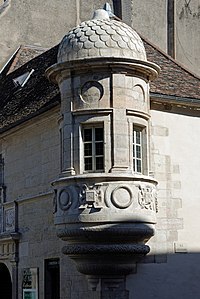Turret (architecture)
This article relies largely or entirely on a single source. (August 2018) |

In architecture, a turret is a small circular tower, usually notably smaller than the main structure, that projects outwards from a wall or corner of that structure.[1] Turret also refers to the small towers built atop larger tower structures.
Etymology
[edit]The word turret originated in around the year 1300 from touret which meant “small tower rising from a city wall, castle, or other larger building.”[2] Touret came from the Old French term torete which is the diminutive form of tour meaning “tower.” Tour dates back to the Latin word turris which also means “tower.”
There is a record from 1862 of turret being used to mean “low, flat gun tower on a warship.” This is about when the word split into two separate definitions, with this definition being the one that goes on to describe gun turrets, a separate idea from the architectural element.
Uses
[edit]Turrets initially arose on castles out of a defensive need for greater visibility. Since they project outwards from the main structure, turrets gave garrisons a better line of sight to spot possible attackers. Thus, they also provided a better defensive position for defensive military forces to originate from. Turrets constructed above the rest of a structure only improve visibility, providing 360-degree views of the surrounding land allowing enemies to be spotted from further away. This provided more time for a fortress’s defenders to prepare for an attack.[3] Turrets offered greater resilience to attacks and were less vulnerable than free-standing watch towers.
As their defensive necessity lessened, turrets began to be used as ornamental elements instead.[4] Turrets were sometimes used to house staircases, and towards the end of the thirteenth century they became important in this fashion. They allowed for the staircases to occupy smaller spaces without affecting the layout of the structure to which they were attached.[5] Since turrets project outward from a structure, they directed attention, and more ornamentation was focused on them than the rest of the facade.
Structure
[edit]Turrets could vary in size, although they all shared the appearance of small towers, either built into walls or atop larger towers. They projected outward from the structure they were incorporated into, greatly contributing to the characteristics discussed in the "Uses" section. Turrets do not extend down to the ground like full-sized towers. When built into walls, turrets are generally found at the corner of structures where two walls meet. Sometimes, however, they are found in the middle of a wall.[3] Since turrets projected outward from a structure, they had to be supported either by weight-bearing corbels or be cantilevered.[4] This put a restriction on how large a turret could be constructed. Turrets were expensive to build, as hoisting stones high above the ground to construct them was highly laborious. It is thought that many were timber-framed and cladded in stone which would have reduced the weight needed to be supported by corbels/cantilevers and reduced the cost of construction.[6] Turrets were traditionally supported by a corbel. The top of a turret could be finished with a pointed roof or another type of apex or might have had crenellations,[7] such as in the image above.
Turrets on Homes
[edit]In the modern day, turrets are most commonly found on homes. These turrets are still towers that project outwardly from the main structure, not extending down to the ground. Residential turrets were greatly popularized in the Queen Anne residential style, and can often be found on a variety of Victorian and Queen Anne home designs today.[8] Some residential turrets are designed to be open-air balconies as well. Turrets can help to bring in more natural light and are often used to create more space in a home. These elements make a property more interesting to prospective buyers and homes with a turret generally appraise higher than without one.[9] Alternatively, turrets usually increase construction costs of a home as they are more difficult to frame and support than more common elements.
Gallery
[edit]-
Hôtel Fumé, Poitiers, France, unknown architect, 15th-16th centuries
-
Hôtel Hérouet, Paris, unknown architect, unknown date
-
Hôtel de Berbis, Dijon, France, unknown architect, 1552-1558
-
Strada Radu Cristian no. 2, Bucharest, unknown architect, c.1900
-
Strada Culmea Veche no. 1, Bucharest, unknown architect, c.1910
-
Maria Ioanidi House on Bulevardul Dacia, Bucharest, by Ion D. Berindey, 1911[10]
-
Turret on the Het Schip housing in the Amsterdam School style, Amsterdam, the Netherlands, 1919, by Michel de Klerk
See also
[edit]- Bartizan, an overhanging, wall-mounted turret found particularly on French and Spanish fortifications between the early 14th and the 16th century. They returned to prominence in the 19th century with their popularity in Scottish baronial style.
- Bay window
- Oriel window
- Turret (Hadrian's Wall)
References
[edit]- ^ Gorse, Christopher A.; Johnston, David; Pritchard, Martin, eds. (2020). A dictionary of construction, surveying, and civil engineering. Oxford quick reference (Second ed.). Oxford: Oxford University Press. ISBN 978-0-19-883248-5.
- ^ "turret | Search Online Etymology Dictionary". www.etymonline.com. Retrieved 2024-11-19.
- ^ a b Chrissy (2020-11-19). "Castle Turrets Explained". Historic European Castles. Retrieved 2024-11-19.
- ^ a b study.com https://study.com/academy/lesson/turrets-in-architecture-definition-design-construction.html. Retrieved 2024-11-19.
{{cite web}}: Missing or empty|title=(help) - ^ SAINT-PAUL, A., & Nodet, H. (1894). TOWERS AND TURRETS.--II. The American Architect and Building News (1876-1908), 45(969), 23-.
- ^ Stalley, Roger A.; Stalley, Roger, eds. (1999). Early medieval architecture. Oxford history of art. Oxford: Oxford University Press. ISBN 978-0-19-210048-1.
- ^ yiselaat (2021-04-26). "Parts of a Medieval Castle: The Turret". Medieval Britain. Retrieved 2024-11-19.
- ^ "Topping it off with Turrets | TMS Architects / Interiors". 2014-01-09. Retrieved 2024-11-19.
- ^ "Turret Roofs: History, Pros & Cons, Styles & More". colonyroofers.com. 2024-08-30. Retrieved 2024-11-19.
- ^ Woinaroski, Cristina (2013). Istorie urbană, Lotizarea și Parcul Ioanid din București în context european (in Romanian). SIMETRIA. p. 212. ISBN 978-973-1872-30-8.









![Maria Ioanidi House on Bulevardul Dacia, Bucharest, by Ion D. Berindey, 1911[10]](http://upload.wikimedia.org/wikipedia/commons/thumb/3/3a/79_Bulevardul_Dacia%2C_Bucharest_%2802%29.jpg/206px-79_Bulevardul_Dacia%2C_Bucharest_%2802%29.jpg)
